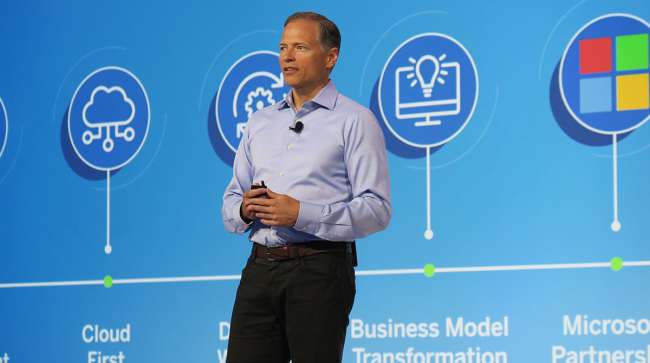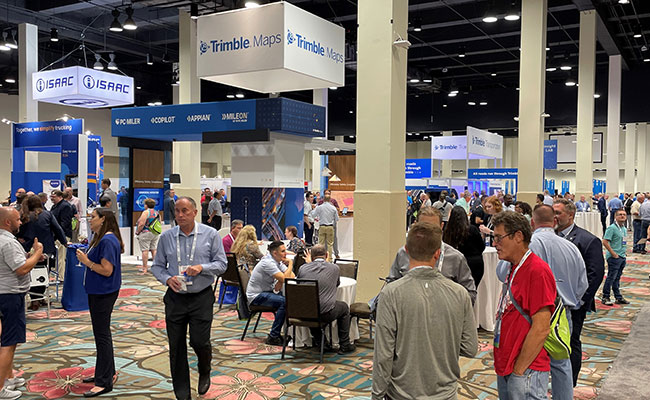Managing Editor, Features and Multimedia
Trimble Invests in Cloud Migration to Enhance Supply Chain

[Stay on top of transportation news: Get TTNews in your inbox.]
ORLANDO, Fla. — Trimble is accelerating its shift toward cloud computing to further connect data and workflows in the freight transportation industry and enable closer collaboration across the supply chain.
The trucking technology supplier outlined its plans to continue scaling up its Trimble Transportation Cloud platform in partnership with Microsoft during its 2022 Insight technology conference and expo, held Aug. 14-17.
“We believe deeply that the world is moving to a cloud-first world,” Trimble CEO Rob Painter said. “That’s where we are incrementally investing our resources.”

A view of the exhibit floor at Trimble's 2022 Insight technology conference in Orlando, Fla. (Seth Clevenger/Transport Topics)
This migration to the cloud — with software and data stored and accessed remotely over the internet rather than on premises — will empower carriers, shippers and brokers to work better together and improve freight management from procurement to planning to execution, Painter said at the conference’s opening session.
The event was held in person for the first time in three years after moving to a virtual format in 2020 and 2021 due to the COVID-19 pandemic.
Trimble is not going it alone on its journey to expand its cloud-based services. In October, the company announced a strategic partnership with Microsoft and its Azure cloud computing business to co-develop cloud platforms for the transportation, construction and agriculture industries.
Jennifer Lin, Trimble’s chief platform officer, highlights the company’s partnership with Microsoft to modernize how it develops industry-focused capabilities in the cloud. @Trimble_Trans #InsightExpo22 pic.twitter.com/VbCexIpI9S — Seth Clevenger (@SethClevenger) August 15, 2022
Jennifer Lin, Trimble’s chief platform officer, said that collaboration with Microsoft will “modernize how we develop and deliver industry-focused solutions in the cloud.”
Trimble has been investing heavily in upgrading its technology. Companywide, Trimble spent more than $536 million last year on research and development.
“We are outinvesting the market in our R&D,” Painter said.
As a percentage of sales, the company is investing more into R&D for its transportation business than for any of the other industries that Trimble serves, he added.
By extracting insights from data, transportation companies have significant opportunities to reduce waste and optimize their transportation networks.
Trimble’s Portfolio
Products and services for the freight transportation industry include:
• Transportation management software
• Truck telematics
• Electronic logging devices
• Mapping
• Truck navigation
• Freight visibility
• Data analytics
• Vehicle maintenance software
Painter said a typical carrier runs about 15% empty miles and 8% out-of-route miles.
For a fleet of 1,000 trucks, improving utilization by 1 percentage point would save about 1 million miles driven every year, add $2 million in profit to the bottom line and remove 3 million pounds of carbon emissions from the atmosphere, he said. “Technology improves resource utilization and makes you more money.”
Fleets also can leverage data and technology to improve driver productivity, Painter said.
He cited an MIT FreightLab study that estimated that the trucking industry could close its capacity gap by unlocking an additional 18 minutes of drive time per driver per day.
“The technology saves you and your drivers time, every single day,” Painter said.
Key Additions
Major acquistions Trimble has made during the past 11 years:
• PeopleNet
• TMW Systems
• ALK Technologies
• 10-4 Systems
• Kuebix
James Langley, senior vice president of Trimble Transportation, said the technology company is focused on helping its fleet customers maximize resource utilization as they adjust their business models to meet the needs of a changing market.
“Carriers are evolving due to digitization and shipper demands for more dynamic capacity,” Langley said, citing examples such as J.B. Hunt’s investments in its J.B. Hunt 360 freight platform and DB Schenker’s acquisition of USA Truck.
In this shifting business environment, Trimble is committed to supporting companies whether they want to be carriers, brokers, asset heavy, asset light or nonasset-based, Langley said.
James Langley of @Trimble_Trans says the company is focused on helping carriers maximize resource utilization as they evolve due to digitization and shipper demand. #InsightExpo22 pic.twitter.com/HgpTlMNOYz — Seth Clevenger (@SethClevenger) August 15, 2022
“We want to meet you where you are and be the platform of choice that allows you to evolve at your pace to meet those needs and solve those problems,” he said.
Trimble’s cloud platform also will continue to connect with applications developed by outside technology vendors.
“We support customer choices and we embrace partners and ‘coopetition’ because your needs are diverse,” Langley said.
Want more news? Listen to today's daily briefing above or go here for more info
The exhibition hall at Insight featured displays and demos from other technology suppliers that offer integrations with Trimble products and, in some cases, products that compete with Trimble.
During the show, Trimble announced a new integration that connects its TMT Fleet Maintenance software with truck maker Navistar’s International 360 repair event management system.
Trimble also discussed recent product updates such as its new mobile operating system, Instinct, which is designed to provide an improved driver experience with applications including driver workflows, electronic logging of hours-of-service data and onboard event recording.
In addition, the company highlighted its Engage Lane transportation procurement platform, which assists carriers and shippers in uncovering better ways to move freight together. Development of that collaborative procurement platform was informed by a partnership between Trimble and consumer goods company Procter & Gamble.

